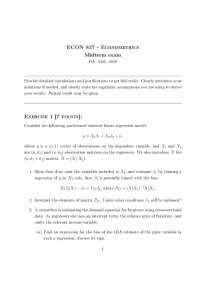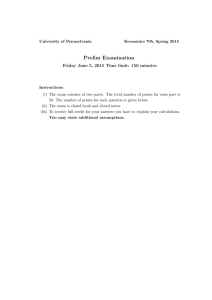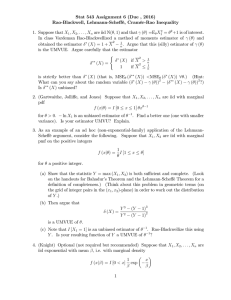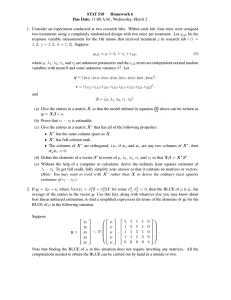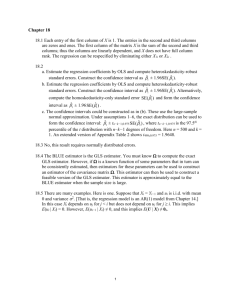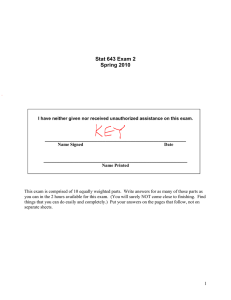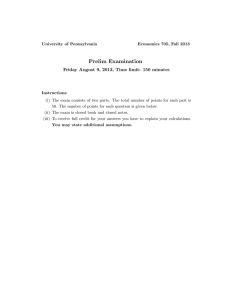Prelim Examination Friday August 7, 2015 Time limit: 150 minutes
advertisement
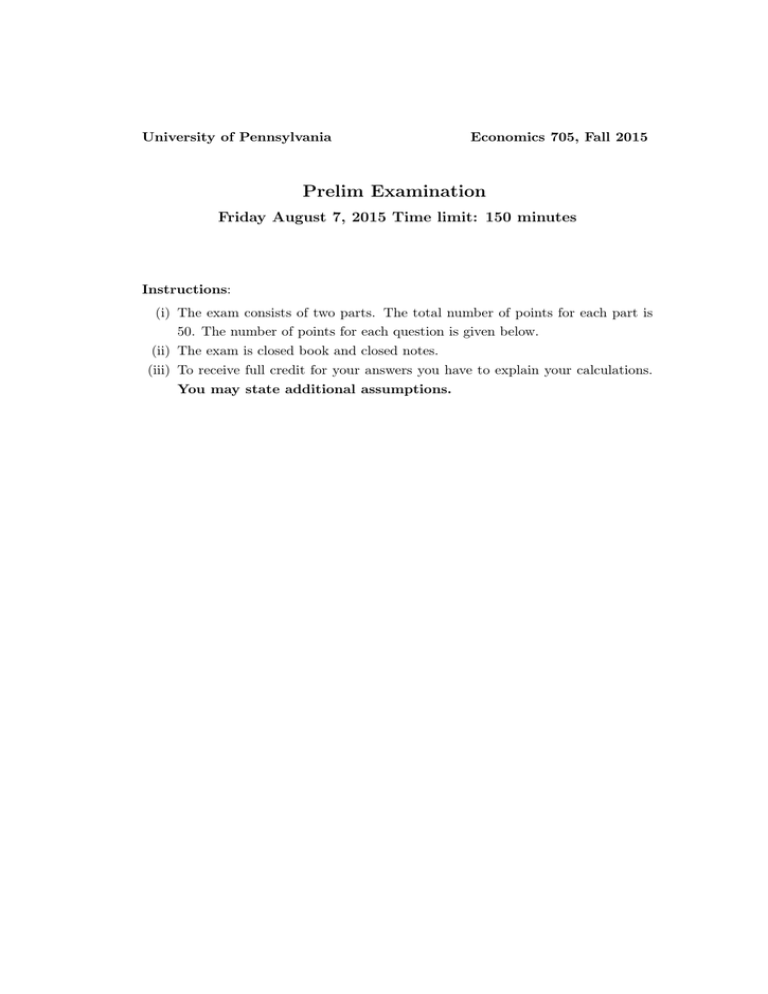
University of Pennsylvania
Economics 705, Fall 2015
Prelim Examination
Friday August 7, 2015 Time limit: 150 minutes
Instructions:
(i) The exam consists of two parts. The total number of points for each part is
50. The number of points for each question is given below.
(ii) The exam is closed book and closed notes.
(iii) To receive full credit for your answers you have to explain your calculations.
You may state additional assumptions.
Xu Cheng and Frank Schorfheide: Economics 705, Fall 2015
2
Part I
Question 1: Probability Density Functions (14 Points)
Two random variables, Y , and X, have a joint distribution characterized by the
following probability density function (pdf):
p(y, x) = cx(x + y),
0 < y < 1, 0 < x < 1.
(1)
(i) (3 Points) Find the value of the normalization constant c that ensures that
p(y, x) is a proper (pdf).
(ii) (3 Points) Are the random variable Y and X independent? Explain.
(iii) (8 Points) Suppose that (Yi , Xi ) are iid with density given by p(y, x) in (1).
An econometrician observes a sample of n observations and runs a regression
of the form
Yi = βXi + residi
(2)
Derive the probability limit (as n −→ ∞) of the OLS estimator of β.
Question 2: Statistical Inference (16 Points)
(i) (4 Points) Suppose you have a test ϕ(Y ; θ0 ) of a null hypothesis H0 : θ = θ0
with type-I error α. Explain how this test can be “inverted” to obtain a 1 − α
confidence set.
(ii) (6 Points) Consider the location model Y ∼ N (θ, 1). Propose a test for the
hypothesis H0 : θ ≥ 0 with size α and derive its power against the alternative
θ = θ̃ < 0. Note: this is a one-sided test. You need to verify that the type-I
error of your test is less or equal than α for each θ ≥ 0.
(iii) (6 Points) Consider the model Y ∼ N (θ, 1) with the constraint θ ≥ 1. Is
the maximum likelihood estimator identical to the posterior mean (you can
assume an improper prior distribution that is uniform on R+ with density
p(θ) ∝ 1 if θ ≥ 0; and p(θ) = 0 if θ < 0)? To answer this question you should
derive explicity formulas for the MLE and the posterior mean.
Xu Cheng and Frank Schorfheide: Economics 705, Fall 2015
3
Question 3: Linear Regression Model (20 Points)
Consider the linear regression model
yi = xi θ + ui ,
ui |xi ∼ iid(0, 1),
xi ≥ > 0,
E[x2i ] = Q.
(3)
The xi ’s are also independent across i, k = 1 and both xi and θi are scalar.
(i) (5 Points) Derive the limit distribution of the OLS estimator.
(ii) (5 Points) Now consider the alternative estimator
n
β̃ =
1 X yi
n
xi
(4)
i=1
Is this estimator consistent? Derive its limit distribution.
(iii) (2 Points) How would you rank two point estimators? According to your
criterion, which estimator, β̂ or β̃, is preferable? Explain.
For the remaining questions we change the assumption on the error term to
ui |xt ∼ iid(0, x2i ).
(5)
(iv) (2 Points) Does the OLS estimator remain consistent if the error term follows
the distribution in (5)?
(v) (3 Points) Derive the limit distribution of the OLS estimator β̂ under the
assumption in (5).
(vi) (5 Points) Derive the limit distribution of β̃ defined in (4). Which estimator,
β̂ or β̃, is preferable?
Xu Cheng and Frank Schorfheide: Economics 705, Fall 2015
4
Part II
Question 4: Linear Instrumental Variable Regression (25 Points)
Take a linear instrumental variable equation
yi = xi β1 + zi β2 + ei ,
E(ei |zi ) = 0,
where both xi and zi are scalars and E(xi ei ) 6= 0. Assume β2 6= 0.
(i) (5 Points) Propose a method to estimate β1 .
(ii) (10 Points) Show the estimator you propose is consistent and derive its asymptotic distribution.
(iii) (5 Points) How would you test the null hypothesis: H0 : β1 = 1 and β22 = 1
versus the alternative that H0 does not hold? Provide the test statistic, its
asymptotic distribution, and the critical value. The nominal level of the test
is α.
(iv) (5 Points) Now suppose you doubt the specification E(ei |zi ) = 0. Propose a
method to test one of its implications.
Xu Cheng and Frank Schorfheide: Economics 705, Fall 2015
5
Question 5: Regression with Binary Dependent Variable (10 Points)
Consider the following model
Yi∗ = Xi0 β + ei ,
where the error has a conditional distribution ei |Xi ∼ N (0, σ 2 ). Only the sign of
Yi∗ is reported. That is, the dataset contains the variable
(
1 if Yi∗ ≥ 0
Yi =
0 if Yi∗ < 0.
(i) (2 Points) Explain why β is not identified.
(ii) (3 Points) Provide an additional assumption under which β is identified.
(iii) (5 Points) Given the identification of β, explain the maximum likelihood estimation of the parameter.
Xu Cheng and Frank Schorfheide: Economics 705, Fall 2015
6
Question 6: Linear Model with Binary Endogenous Variable (15 Points)
Consider the following model
Yi = Xi β + ei ,
where Xi ∈ R is an endogenous dummy variable. We assume
Xi = 1{Wi > vi },
where Wi ∈ R is independent of ei and vi , ei ∼ N (0, 1), vi ∼ N (0, 1). We have i.i.d.
observations {Xi , Wi , Yi }ni=1 .
(i) (5 Points) Suppose ei and vi are independent, how would you estimate β?
(ii) (5 Points) Suppose ei and vi are correlated, how would you estimate β?
(iii) (5 Points) In both cases, provide the asymptotic distributions of the estimators
of β.

